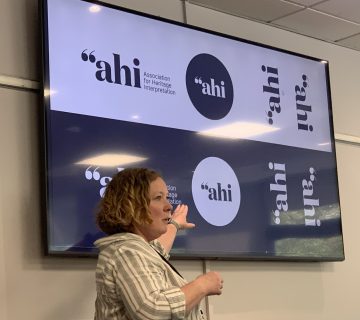Interpret Europe starts a five-year collaboration to foster a new interpretive approach for World Heritage Sites.
On 8 October 2024, the directors of Interpret Europe and WHIPIC, Helena Vičič and Chang-nam Hong, signed a Memorandum of Understanding. The agreement provides a framework for collaborations in research and capacity building which aim at furthering value-based, more inclusive and people-centred approaches in the interpretation and presentation of heritage.
WHIPIC, the International Centre for Interpretation and Presentation of World Heritage Sites, was established in 2022 as a UNESCO Category 2 Centre in Sejong-si, Korea, out of the growing need for in-depth research and development of 21st century heritage interpretation theory and techniques.
WHIPIC and Interpret Europe are both dedicated to creating an environment where all groups who feel related to a heritage suite can actively participate in the process of heritage valuation and promote its values. We both aim to enhance the theory and practice of heritage interpretation in order to address contemporary challenges due to globalisation and climate change. There is an urgent need to accelerate transformation towards sustainability and social justice, based on respect for human dignity and universal human rights.
In this context, it can really matter how people interpret ‘their own’ heritage and how they perceive other people’s history and heritage. Neglect or misrepresentations, disinformation and outright contempt of ‘the others’ can put people against each other.
Interpretive presentations of heritage can do both, enhance mutual understanding between people from diverse backgrounds, or – inadvertently or deliberately – sow division and conflict within plural societies and international organisations. They can contribute to understanding of and respect for human rights or they can undermine the defences of peace in people’s minds.
Mutual benefits of our collaboration
During the last decade, Interpret Europe began to develop a value-based approach which is underpinned by a better understanding of universal and culture-specific aspects of basic human values. This is still work-in-progress. While some tools and methods have already been included in IE’s training programme, we still need to further develop a professional code of ethics, principles and practical guidelines for value-based heritage interpretation in European. This is one of the major tasks IE wants to tackle between 2025 and 2029 through the HI-People project. This project allows us to involve members and other heritage stakeholders in a broader discussion to ensure that the value-based approach will be useful for practitioners who work in different contexts.
At the same time, WHIPIC began a research project to review the definitions of ‘heritage interpretation’ and ‘heritage presentation’.These are considered as two different but overlapping activities in the context of UNESCO’s World Heritage system (cf. the ICOMOS Charter for the Interpretation and Presentation of Cultural Heritage Sites). In 2024, Patrick Lehnes, IE’s Cultural Heritage Coordinator, was invited to join a team of expert advisors for a follow-up research project on new principles for heritage interpretation and presentation. WHIPIC’s project aims to support UNESCO’s World Heritage system, but it also wants to inspire other heritage sites.
Interpret Europe benefits from WHIPIC’s global approach, which involves experts and stakeholders from other cultural backgrounds. On the other hand, IE contributes with considerations, tools and methods developed within its value-based approach. The collaboration allows us to align our respective ‘principles and guidelines’ as much as possible. But IE will still need freedom to adapt the principles and guidelines to the specific needs of interpreters who work in European contexts with a great variety of moveable and immovable, tangible and intangible heritage assets of local, regional or global significance, while the WHIPIC principles must be compatible with the doctrinal texts of UNESCO’s World Heritage system.
During the next five years, both organisations will also support each other and conduct joint activities in other areas, such as applied research and capacity building for World Heritage sites in Asia, Africa and Oceania. The EU grant that IE will receive from 2025, will enable us to intensify this collaboration. WHIPIC intends to also regularly visit IE conferences and thus engage European interpreters in its activities.
Our MoU was signed at the sidelines of two international workshops and a conference organised by WHIPIC which brought together several experts from around the globe from academia, law, heritage management, conservation and other related disciplines, including an NAI representative. We took part in inspiring and fruitful discussions which are promising for a mutually beneficial collaboration in the coming years.
Helena Vičič is IE’s Managing Director. She can be contacted at: helena.vicic@interpret-europe.net.
Patrick Lehnes is IE’s Cultural Heritage Coordinator. He can be contacted at: patrick.lehnes@interpret-europe.net.
To cite this article: Vičič, Helena & Lehnes, Patrick (2024) ‘New partnership with UNESCO WHIPIC‘ in Interpret Europe Newsletter 3-2024, pg.7-8.
Available online: PDF-Newsletter_2024_3.pdf




